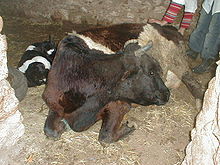Milk fever
Milk fever, post-parturient hypocalcemia, or parturient paresis is a disease, usually of dairy cows, characterized by reduced blood calcium levels.
It is most common in the first few days of lactation, when demand for calcium for milk production exceeds the body's ability to mobilize calcium reserves.
"Fever" is a misnomer, as body temperature during the disease is usually below normal. Low blood calcium levels interfere with muscle function throughout the body, causing general weakness, loss of appetite, and eventually heart failure.[1]
Hypocalcemia is more common in older animals (who have reduced ability to mobilize calcium from bone) and in certain breeds (such as Jersey cattle).
Hypocalcemia, like milk fever, occurs occasionally at any time during the lactation or pregnancy and in many mammalian species.
Clinical symptoms


In mild cases, the animal seems quite normal, but has difficulties standing. If the cow succeeds in rising, she staggers, and will very soon fall. The cow's appetite can be maintained at that stage. Body temperatures are from 37 to 38.5°C (normal range 38-38.5°C).[2][verification needed] This stage, referred to as "first degree", corresponds to calcemiae of 55 to 75 mg/l.
In typical cases, the cow's head is in a so-called self-auscultation position. Mydriasis is often present. The heart can be slow or arrhythmic. The body temperature is 35 to 37°C. In that stage, referred to as "second degree", calcium levels in the blood are of 30 to 65 mg/l.
In advanced cases, the cow is lying on its side, seeming dead. The body temperature can go as low as 32°C. This is the 3rd degree, with calcemia as low as 20 mg/l.
Treatment
Treatment generally involves calcium injection by intravenous, intramuscular or subcutaneous routes. Before calcium injection was employed treatment comprised inflation of the udder using a pneumatic pump. [3]
Intravenous calcium, though indicated in many cases, is potentially fatal through "heart blockade", or transient high calcium levels stopping the heart, so should be administered with care.
In unclear cases of downer cows, intravenous calcium injection can lead to diagnosis. The typical reaction will be a generalized tremor of the skeletal muscles, and sometimes cardiac arrhythmia. Defecation, urination and eructation are frequent during the treatment, due to pharmacological effect of calcium on the smooth muscles. In stage I and II, The cow can stand up approximately 10 minutes after the end of the intravenous injection. But in stage III, it may take two or three hours.
The prognosis is generally good, even in advanced cases. However, some patients can relapse the following day, and even a third time the day after.[2]
Prevention
Proper dietary management will prevent most cases of milk fever. This generally involves close attention to mineral and fiber levels in the pre-calving diet as well as improving cow comfort to eliminate other problems that may interfere with appetite and so trigger hypocalcemia.
Oral administration of a dose of a calcium salt in a gel have been advised by some veterinarians.[4]
References
- ^ Veterinary Medicine (5th ed.). London: Baillière Tindall. 1979. pp. 827–836 (Parturient paresis or milk fever). ISBN 0-7020-07-18-8.
{{cite book}}: Unknown parameter|coauthors=ignored (|author=suggested) (help) - ^ a b Lucien Mahin (1977–2008), Observations on diseases of cattle in Morocco
{{citation}}: CS1 maint: date format (link) (unpublished data) - ^ Nidermeier, R.P. (1950), "The Effect of Udder Inflation Upon Blood Levels of Calcium, Magnesium and Phospherous in Cows with Parturient Paresis", Journal of Dairy Science, 33: 38–42
- ^ Haalstra, R.T. (1973), Tijdchrift voor Diergeneeskunde, vol. 98, p. 529
